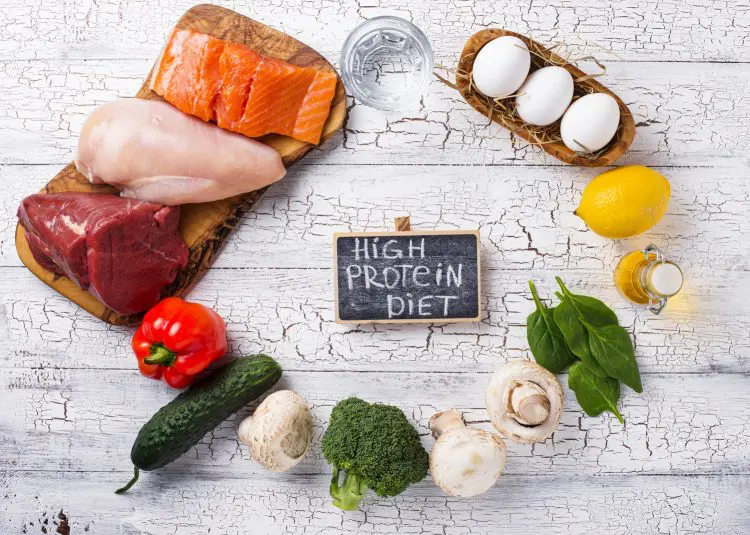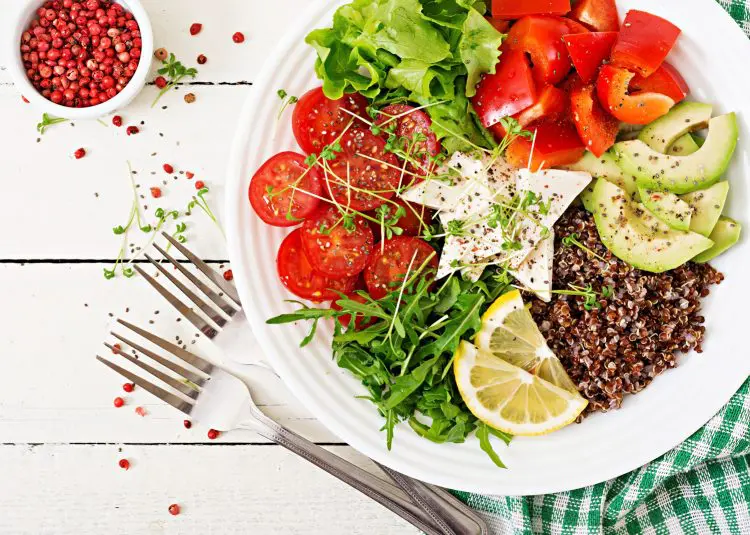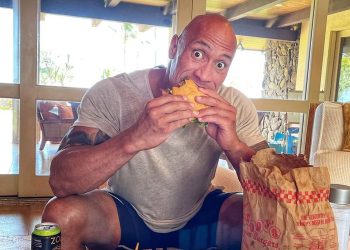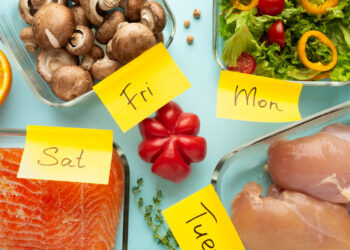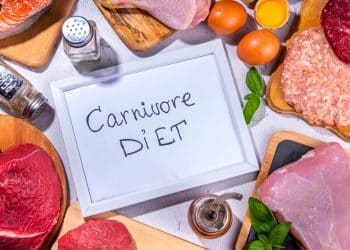While bulking isn’t for everyone, it’s one of the most proven and effective methods for slapping on pure mass. So if you’ve decided that you’d like to fast-track your progress this year, we put together a banging bulking meal plan to get you started and continuing on your journey to Jackedville!
Keep in mind though, that not everyone has the same caloric and nutritional requirements. So an ideal diet plan may be different for you than it would be for someone else. For example, factors such as your metabolic rate, level of training experience, activity/workout routine, genetics, health, age, gender, etc, all play an important role in how you approach a bulk.
Don’t worry though, by simply starting, you’ll find what works best for you and it’s not a complex process. Although we’ll do our best to make it as easy as possible for you.
Just promise us that you won’t become a bulker for life or overdo it because the ultimate goal is to get lean and show off what you’ve been busting your butt in the gym for all this time.
What’s The Purpose of A Bulk?
The purpose of a “bulk” is to gain size faster. While many don’t believe in bulking for whatever reason and that’s totally fine, it is an effective and proven method.
Clean vs. dirty bulking
There are essentially two variations of this method that are categorized as “clean” and “dirty” bulking. Clean bulking is when you consume slightly more calories than what is needed to maintain your body weight, also known as a caloric or energy surplus.
Level Up Your Fitness: Join our 💪 strong community in Fitness Volt Newsletter. Get daily inspiration, expert-backed workouts, nutrition tips, the latest in strength sports, and the support you need to reach your goals. Subscribe for free!
Dirty bulking, on the other hand, typically involves a larger caloric surplus compared to a clean bulk.

So for example, if you require 2000 calories to maintain your current body weight, you might eat only 250 additional calories per day. But if you were dirty bulking, you might increase that to 500+ additional calories over maintenance.
Then you can gradually increase your daily calories if needed to continue gaining body weight.
When done strategically, a clean bulk should minimize fat gain whereas you’ll typically accumulate more body fat on a dirty bulk.
While bulking is a strategy that is most often utilized for the purpose of gaining muscle mass, many times bodybuilders bulk up in the offseason simply because they want to give themselves a break from the extreme dieting required to get down to a super low body fat percentage.
This can happen naturally and without much effort. However, for non-natural bodybuilders, the chances of adding fat mass is much less likely unless you maintain a relatively low body fat year-round.
It’s also important to note that clean and dirty bulking are also many times associated with “cleaner” (healthier) or “dirtier” (less healthy) food choices. But this becomes complicated once you start to get real technical so we’ll keep it at the number of calories rather than getting into specific food choices (for now at least).
Which bulking method to do?
The clean bulk is the more recommended out of the two. Does that make it better? The short answer is no. However, a larger majority of people prefer to avoid packing on more fat pounds than necessary. Plus, eating a crap ton of food every day for months isn’t appealing to everyone.
But it really depends on those factors mentioned at the very beginning of this article (metabolic rate, level of training experience, activity/workout routine, genetics, health, age, gender, etc).

A dirty bulk can certainly cause more muscle gains compared to a clean bulk but then you have to do a longer cut after. It’s also not recommended for long periods or for those with health issues. And many would argue that it’s best for those with very good genetics who can easily pack on muscle.
A clean bulk should be done for longer periods (e.g., 6-12 months), and while a dirty bulk can be done for just as long, that’s a lot of fat gain. Shorter periods of 4-6 months are often superior, considering you’ll gain more muscle if it’s done correctly.
But if we had to choose, the clean bulk would be the choice for most people. That’s not only because you’ll gain less fat, but too many people use a dirty bulk as an excuse to pig out and they may end up bulking for too long.
So for clean bulking, this means keeping the calories at 10–20% over maintenance and aiming for a 0.25–0.5% increase in body weight for beginner and intermediate lifters. More advanced exercisers should aim to gain less weight per weight which means they’ll need to consume a smaller caloric surplus comparatively (1).
Ultimately though, it’s up to the individual and we cannot make that decision for you. We can only recommend what we believe to be an ideal approach to this method.
The Bulking Meal Plan
We have plenty of amazing articles on bulking that you can check out on your own time.
The point of this article is to provide you with a meal plan that you can follow whether you’re beginning or continuing your bulking journey.
Keep in mind though, that we cannot tell you how much of each food item or the total number of calories you should be eating because this is going to vary between individuals.
But we do recommend using our macro calculator to determine your ideal daily protein, carbs, and fat intake, in addition to our bulking calculator, and our nutrition facts analysis tool or MyFitnessPal. This way you can easily and conveniently determine and keep track of your macros and calories.
We’ve also made sure to include a few different options including a vegan or plant-based meal plan too.
The plan is based on a 7-day week schedule with examples of how to structure your meal/food times. The food recommendations are healthy options, but whether or not you want to include less-healthy foods is up to you and you’ll have to factor that into your macros and calorie total.
If possible, we recommend sticking with the same meals which just makes things a bit easier regarding tracking macros and manipulating your caloric intake. Although, you can certainly change things up whenever needed.
Alright, let’s get to the PLAN!
Bulking Meal Plan
The following is based on a 5-meal per day plan, although you can modify if necessary. These are only a few meal options but they’re simple to make and we would eat them ourselves.
Level Up Your Fitness: Join our 💪 strong community in Fitness Volt Newsletter. Get daily inspiration, expert-backed workouts, nutrition tips, the latest in strength sports, and the support you need to reach your goals. Subscribe for free!
Try your best to buy/use quality foods such as lower-fat grass-fed meats, pasteurized eggs, low-sugar, and low-fat condiments and sauces.
We’ve also provided three or more options for some meals. We also recommend that you take a multivitamin and have a protein powder supplement on hand.
Creatine is also incredibly beneficial when bulking as it’s the most proven and effective ergogenic muscle and strength builder available. Because creatine is naturally found in meats, vegans will especially benefit from supplementation as they likely have low stores of this amino acid (2).
Those who follow the vegan may also want to take a B12 supplement too for maintaining good health.
Note: Choose from any of the options provided in bullets below for each meal.
Meal 1
- Minimum 2 whole eggs, oatmeal w/ liquid of your choice, berries, and green superfoods drink
- Protein shake (use liquid of your choice) w/ frozen banana, oats (not cooked), 1.5-2 tbsp nut butter of your choice
- Bacon, eggs, hash browns, half an avocado, and berries
- Protein pancakes
Meal 2
- Chicken or turkey breast (use a little bit of healthy oil to cook the chicken breast for a good source of fats), sweet potatoes, leafy greens, a serving of creatine
- Turkey, chicken, or tuna sandwich on Ezekiel or whole-grain bread or on a wrap. Don’t overdo the mayo or other fatty or sugary condiments and go light on the cheese. Ideally, the meat should be cooked or bought fresh from the deli (not super-processed pre-packaged meat).
- Ground chicken, turkey, or beef with rice and mixed vegetables. Avoid using too much of or many fatty or sugary condiments.
Meal 3 (post-workout)
- Whey protein shake, fast-digesting carb like fruit/natural fruit juice, or carb shake
- Low-fat meat w/ whole-grain or vegetable pasta and light sauce plus green veggies
- Chicken breast and root/tuber (potatoes, yams, yuca, etc) of your choice with green veggies
Meal 4 (snack)
- Nut butter on toast
- Protein bar
- Low-fat, low-sugar trail mix
- Loaded salad
Meal 5 (bedtime meal/snack)
- Choose any option from meal 2
- Casein protein shake (slower-digesting option for overnight muscle fuel)
- Cottage cheese
- Low-fat milk
- Nuts or nut butter
Vegan/plant-based bulking meal plan
The following regime is for those who follow a vegan/plant-based diet.
Meal 1
- 2 rice cakes lightly toasted (makes it crispier), with 1-1.5 tbsp almond or peanut butter for each rice cake, one large banana sliced (place slices on top)… super easy, simple, and delicioso!
- Plant-based protein shake w/ water or plant-based liquid (almond, soy, oat milk, etc), frozen banana, oats (not cooked), 1.5-2 tbsp nut butter of your choice
- Protein pancakes
- Breakfast burrito: Tofu scramble (vegan version of scrambled eggs), diced cooked potatoes, onions, red bell peppers, mushrooms, half an avocado, arugula or spinach, and salsa all encased in a tortilla. Feel free to modify how you like. Use your favorite seasonings and add some non-dairy milk to make the scramble creamy.
- Acai bowl (smoothie in a bowl with everything you love)
Meal 2
- 1-2 black bean, lentil, or soy patties w/ 1 tbsp condiment of choice, white or brown rice, half an avocado, and green vegetables, i.e., spinach, kale, chard, broccoli, greens, etc
- Pasta salad (your choice of noodles with cherry tomatoes, black beans, vegan cheese, onions, corn, bell peppers, peas, etc).
- Quinoa salad (so many different variations)
- Vegan soup (lentil spinach, southwest style, etc)
- Smashed garbanzo beans with Vegenaise mayo, onions and dill wrapped in a toasted pita… it’s that simple!
Meal 3 (post-workout)
- Plant-based protein shake, fast-digesting carb like fruit/natural fruit juice, or a homemade carb drink
- Vegan pizza with non-flour base, fat-free or low-fat cheese, and light sauce
- Butternut squash and tempeh tacos
- Acai bowl
Meal 4 (snack)
- Dairy-free yogurt protein pudding or green protein smoothie (also great breakfast options)
- Nuts, chia/flax seeds, berries, and vegan yogurt
- Loaded salad
Meal 5 (bedtime meal/snack)
- Choose any option from meal 2
- Protein shake
- Roasted chickpeas
- Hummus and veggies (or whatever you prefer)
- Vegan jerky
Emphasize Your Protein Intake…
It’s no secret that protein is key for maximizing muscle growth, strength, and performance.
Although, it’s considered a macronutrient so we need plenty of it for basic health and function anyway. However, you need the right combination of proteins to ensure that you’re consuming complete sources containing all nine essential amino acids (building blocks of protein).
Most plant-based proteins are not complete due to missing one or more essential amino acids. But you can, in fact, fix this by eating a variety of plant proteins. Although ideally, you’ll eat some animal-based protein too which are complete sources, if you’re not vegan or vegetarian of course.
But the important thing is to have some protein every time you have something to eat to ensure that your muscles are being fed throughout the day. Not to mention, you need to be taking in the right amounts of carbs and fats too.
The recommendation for natural bodybuilders in the off-season is to keep fats at 0.5–1.5 g/kg/day and carbs at ≥3–5 g/kg/day to support the demands of training (3).
Although you don’t necessarily have to count and keep track of everything (ain’t nobody got time for that… unless you’re a professional bodybuilder/athlete).
But you should have a general idea of the desired macro ratio based on your food selections or meal portions.
Don’t think you need to watch your macros, bro?
Think again.
One review of studies found that overfeeding or eating excess calories in combination with a high-protein diet can have protective effects against fat gain, whereas overfeeding on fats and carbs contributes to more fat gain. Although this is especially true with the addition of resistance training (4).
Well, at least that’s according to this specific study. But everyone knows you need to be in a positive nitrogen balance to get them gains! You may not need as much as you think though. Although it’s possible you may not be getting enough protein.
How much protein should I eat every day while bulking?
The general recommendation for maximum muscle gains is (1.6–2.2 g/kg/day) with 0.40–0.55 g/kg per meal spread out over 3-6 meals. It’s also very important to have protein before and after training (5).
Who Should Try This Bulking Meal Plan
If you’re a seasoned bulker, then you probably have your own way of doing things (you’re more than welcome to stay though). But even experienced lifters can benefit from bulking too and it can actually help to push past plateaus.
This meal plan is ideal for those who are:
- New to bulking or training
- Male and female
- Serious about packing on size
- Wanting to change things up a little
- Not suffering from any serious health conditions
Like we mentioned previously, bulking is not for everyone. For many, the slower, longer road is undoubtedly the better option. And by that, we mean keeping your calories around maintenance (eating enough to maintain your weight and gain at a very slow rate) or even slightly under (losing body fat while gaining muscle at an even slower rate).
Although, if you’re new to resistance training whether under or overweight, you’re going to gain a lot more muscle a lot faster compared to someone who has been training for six months or longer. This is referred to as “newbie gains.”
Wrapping Up
Bulking doesn’t have to be difficult but sometimes we make it that way. But hopefully, with this bulking meal plan, you’ll have another super beneficial tool in your arsenal to ensure that you’re making the gains that you deserve.
As always, if you have a question/s about any of the information in this article, please don’t hesitate to leave your comments below. Also, be sure to read how to Get BIG With Our Ultimate Bulking Workout Plan.
Cheers!

